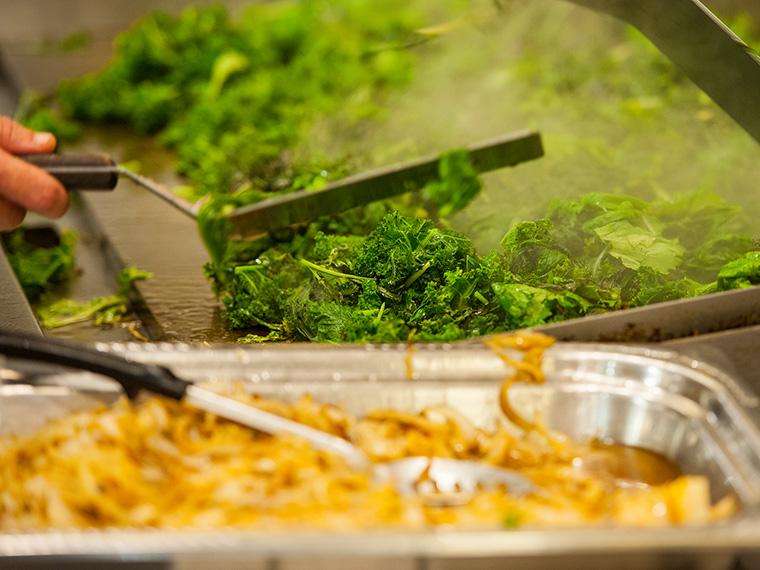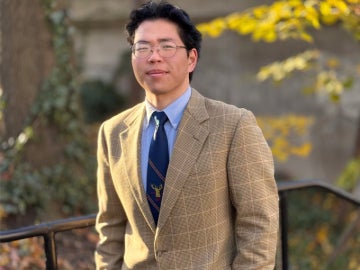Eat Local Challenge Celebrates Commitment to Local Food
October 6, 2015
Kasey Cheydleur

Photo credit: Walter Novak
Produce often travels 1,500 miles between farm to consumer, but as part of the Eat Local Challenge on September 29, students, staff, and faculty had the chance to eat a meal sourced completely locally. Every ingredient was produced within 150 miles of the Oberlin kitchens, down to the herbs on the pork loin. Those dining in Dascomb Dining Hall were served Lake Erie walleye with hollandaise sauce, sides of parsley redskin potatoes and fresh vegetables, and a local honey and parsnip ice cream apple cider float topped with apple butter crisp. Stevenson Dining Hall served herb-marinated pork loin as well as heirloom tomato and plum relish, buttery yukon hash browns, sauteed garlic kale, and an apple crisp bar.
The Eat Local Challenge is a natural extension of both Oberlin College’s commitment to sustainability and the mission of Bon Appétit Management Company, the college’s food provider, to promote healthy, local products. In 1999 Bon Appétit launched its Farm to Fork program in which the provider pledges to purchase at least 20 percent of its goods from farmers, artisans, ranchers, and businesses within 150 miles of its kitchens. Today, more than 1,200 vendors are registered with the program. Farm to Fork favors small businesses owned by families who work the land themselves, as well as farmers who preserve plant diversity by growing heirloom vegetables instead of genetically modified produce. On a daily basis Oberlin sources approximately one third of its food from local sources and partners with more than 35 vendors in the local area—some as close as George Jones Farm and Tyler’s Farm, both located less than two miles from Tappan square.
John Klancar, Bon Appétit director of operations, is in charge of discovering local vendors and maintaining Oberlin’s relationship with its longtime local partners. “You get to visit some interesting places, meet a lot of interesting people, and form great relationships with them,” Klancar says of his job. These relationships are crucial to an undertaking such as the Eat Local Challenge, where communication and flexibility play a large role in what ends up on diners’ plates.
In addition to the community partners, Klancar says the Eat Local Challenge is a massive team effort that includes Campus Registered Dietitian Eric Pecherkiewicz, the chefs, and all the Oberlin staff. Klancar says he enjoys the challenge because it is both a celebration of the relationships Oberlin shares with its local partners and a chance to push the envelope. “We can think outside the box and think local,” he says. This year’s challenge, for example, featured parsnip ice cream—which, while it earned skepticism at first, turned out to be one of the biggest hits of the night. Dishes served at the challenge also sometimes spark ideas for the future.
In addition to the local food in the dining halls, students were also invited to sample products from local vendors outside of Wilder Hall. Students sipped on coffee roasted by Caruso’s Coffee in Brecksville, Ohio, while they munched on varieties of flavored popcorn, from American Classic Snack located in Wadsworth, Ohio, or sampled cheeses from Middlefield Original Cheese Co-op from Middlefield, Ohio. Yogurt came from Velvet-View Farmstead, located in Holmes County, Ohio, which prides itself on the freshness of its yogurt and boasts a 24-hour cow to consumer turnaround.
Looking to the future, Bon Appétit plans to continue the Eat Local Challenge and expand its local food programs. The company also hopes to keep addressing farmworkers’ rights and the role food production plays in climate change as Bon Appétit continues to work toward a more sustainable future.
You may also like…
Learning by Teaching: Oberlin Students Share Global Music with Young Learners
College and Conservatory students in PACE 103 prepare local children for an immersive community concert at Oberlin.
Nuiko Wadden ’02 Joins Oberlin Conservatory Faculty as Assistant Professor of Harp
The versatile musician brings extensive opera, orchestral, and contemporary music experience to her role
Leo Hidy ’23 Earns 2026 Marshall Scholarship
Leo Hidy ’23, a comparative American studies major who also studied business and economics while at Oberlin, has received a 2026 Marshall Scholarship that will fund two years of graduate study in the UK.


